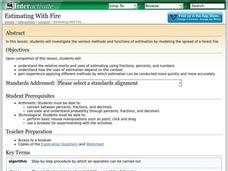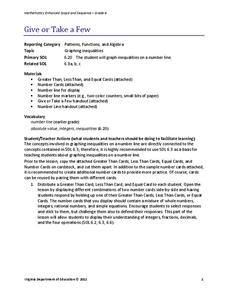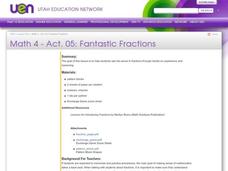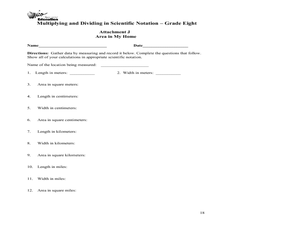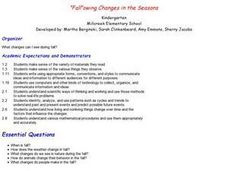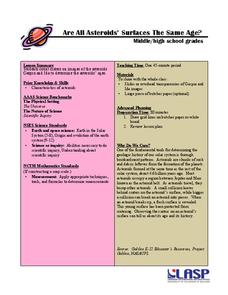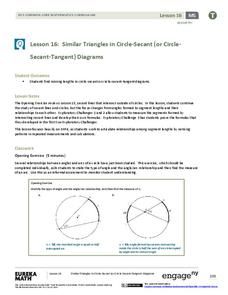Shodor Education Foundation
Estimating With Fire
Watch the damage from a forest fire in this interactive simulation activity that challenges learners to estimate the burn area using different approaches. Learners are given a worksheet to track the different burn patterns and practice...
Virginia Department of Education
Give or Take a Few
Young mathematicians extend their knowledge of rational numbers on a number line to graph inequalities by first using number cards to compare rational numbers. They finish by using similar reasoning to graph inequalities on a number line.
Curated OER
All About Me Books
Students examine literature of emergent readers, categorize books into types of literature common for primary readers (wordless, pattern, alphabet, number, rhyme, etc.), and write a book about themselves to give as gifts to their new...
Curated OER
Painting Package
Students use tools in a painting package to design tiles and create repeating patterns. They design a single tile using a 4 x 4 grid and experiment with changing the alignment of some of the tiles by rotating different areas.
Curated OER
Fantastic Fractions
Fourth graders explore and examine through hands-on experience and reasoning the concept of fractions. They solve problems involving multiplication and division of whole numbers and addition and subtraction of simple fractions and decimals.
Curated OER
Using Garage Band to Enhance 2nd Grade Composition
Your second graders can become composers with a little help from the Garage Band software. You pre-select several drum, piano, and guitar loops for the groups to choose from, then they put them together following an ABA looping pattern....
Ohio Department of Education
Multiplying and Dividing in Scientific Notation - Grade 8
Here is really nice set of resources on scientific notation. Eighth and ninth graders explore the concept of multiplying and dividing in scientific notation. In this multiplying and dividing numbers in scientific notation...
Curated OER
No Title
Third graders assess how to read and write rhythmic notation in music. They explore the concepts of whole, half, quarter, eighth, dotted lines, extended pentatonic, diatonic and major/minor modes. Symbols along with additional...
Virginia Department of Education
Transformations
The coordinate plane is a popular place! Identify rotations, reflections, and dilations on the coordinate plane. Pupils work in small groups to match transformations of a figure with the description of the transformation....
Kenan Fellows
How Does an Unhealthy Diet Influence our Health and Well-Being?
You are what you eat, or so they say! After surveying family and friends on a week of eating habits, learners analyze the data for patterns. They compare different variables such as fats and cost, fats and calories, or fats and LDLs.
Curated OER
Marvelous Mathematics
Students make a table on the computer, but create fractions and equivalent fractions through the use of color. They are able to manipulate fractions in order to gain a greater understanding of the meaning of whole number that is broken...
Curated OER
Dance is B.E.S.T.: Time
Students demonstrate dance activities and rhythm activities to whole, half, quarter, and eighth notes. They clap and move to notes individually and in 16 count metric phrases. As they create different 16 count metric phrases and...
Curated OER
Indian Ragas
Students explore Indian ragas and learn the differences between an Indian raga and the Western scale. They sing the familiar song "America," first in the Western major scale and then in two Indian ragas (bhairavi and purvi) on a neutral...
Curated OER
Quilt Block Collage
Learn the art of quilting with this lesson plan that can be connected to a history lesson plan on quilts in Ancient Egypt, China, and modern art. After studying a general history of quilts, its uses, and the history of different...
Curated OER
Powerful Poetry
Young scholars examine Haiku poems and analyze their meanings. They create a whole class Haiku, then develop their own poems.
Curated OER
"Fall"owing Changes in the Season
Students create a whole class A-B-"C"eason Book. Each student is responsible for creating a "letter" page relating to changes, adaptations, or other fall concepts. After hard copies of the class ABC books are created, the teachers using...
Curated OER
The Value of Behavioral Variation in Homo sapiens
Students look at the behavioral characteristics of their peers from a historical perspective, and realize that, in the larger scheme of a community, these behaviors do have some value, and that a society as complex as ours does need the...
University of Colorado
Are All Asteroids' Surfaces the Same Age?
Did you know scientists can tell the age of an asteroid by looking closely at its craters? This final instructional activity of a six-part series focuses on two asteroids, Gaspra and Ida, in order to demonstrate the concept of dating...
02 x 02 Worksheets
Inverse Variation
Discover an inverse variation pattern. A simple lesson plan design allows learners to explore a nonlinear pattern. Scholars analyze a distance, speed, and time relationship through tables and graphs. Eventually, they write an equation to...
Curated OER
Investigate Science Using Crayfish
Young scientists discover the importance of scientific investigation by observing live crayfish. They carefully observe the patterns of crayfish in different environments. Then they discuss their conclusions and define what all living...
Curated OER
America: The Land We Live In: Landmarks
Students explore the concept of landmarks. In this landmark instructional activity, students brainstorm different landmarks around their community and nationally. Students then identify the patterns in Georgia O'Keeffe's...
EngageNY
Similar Triangles in Circle-Secant (or Circle-Secant-Tangent) Diagrams
First angle measures, now segment lengths. High schoolers first measure segments formed by secants that intersect interior to a circle, secants that intersect exterior to a circle, and a secant and a tangent that intersect exterior to a...
Dick Blick Art Materials
“Rhythm in Layers”
Young artists learn to build rhythm into a design by repeating colors, shapes, and patterns in a 3-D sculpture activity.
Mathematics Assessment Project
Discovering the Pythagorean Theorem
Young mathematicians join the ancient order of the Pythagoreans by completing an assessment task that asks them to find the area of tilted squares on dot paper. They then look at patterns in the squares to develop the...
